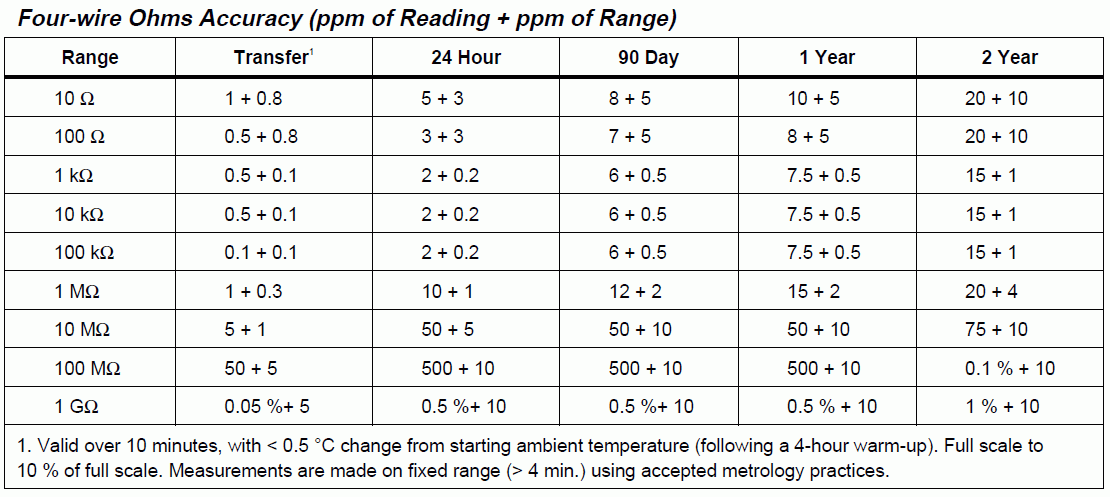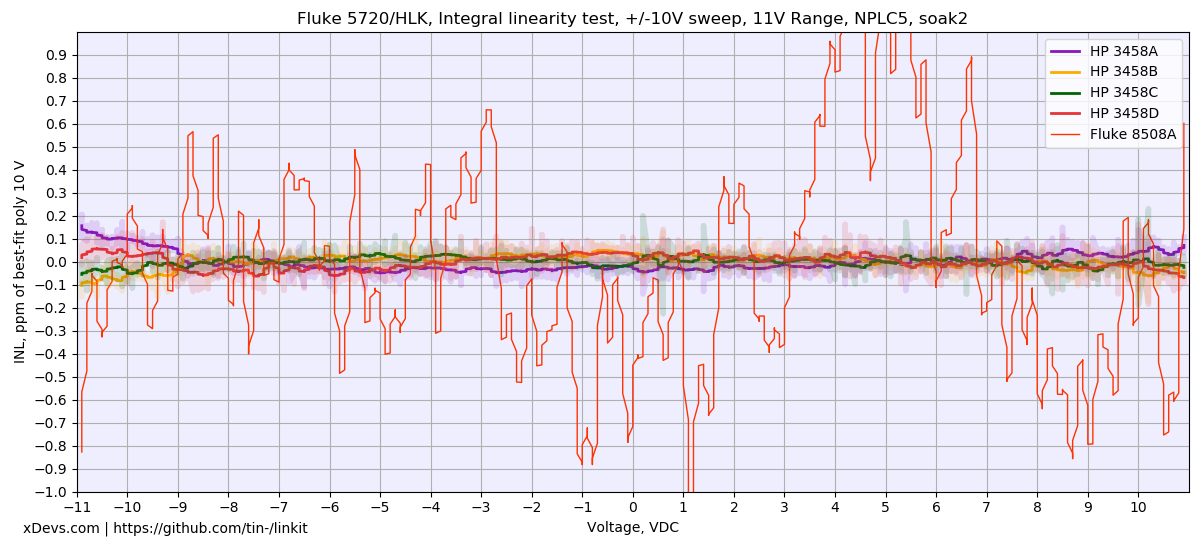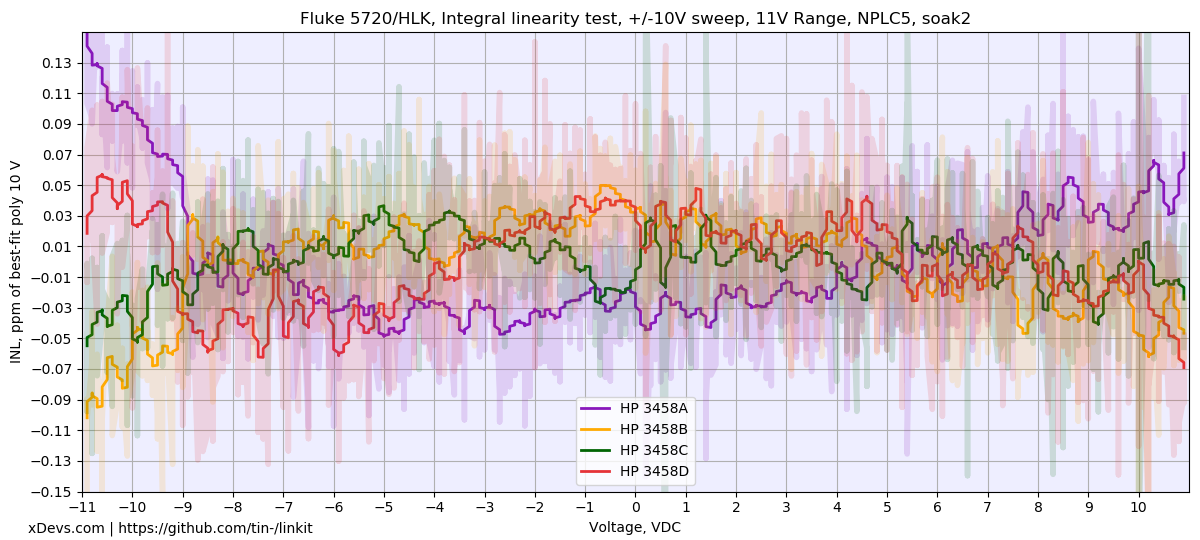e61_philI always welcome a discussion on these complex topics, not pretending to know everything, still learning here.
I don't expect in any Fluke spec that it will reflect only typical values or best case data.
Not argue with that. But it looks to me that "not so good" specifications like INL are conveniently "omitted" from the 8508A documentation, as statement like <1ppm it would not look good against 2 times cheaper and 10 year older competitor unit, that states 0.1ppm max.
And what is the point of INL specification in the end?
Great INL is what makes 8.5-digit meter a meter, not an indicator. If you trying to do compensation for tempco/power coefficients and similar analysis, without knowing actual INL how one can get accurate results and be confident that deviations are not come from inherent ADC error contributions. This can be handy to investigate front-end performance, because there are many ranges in meter, and error characteristics on them are different.
Also you can get idea of transfer spec from
HP's 3458HFL spec sheet which is just selected 3458A (unless I'm proven wrong with actual HFL unit guts photos):

Now back to the 1kV range. 3458A calibration manual clearly states:
Normal 100 V and 1000 V range measurements use a 100:1 resistor network to attenuate the input. To correct errors introduced by this network, we apply zero volts to the input. Then, we apply 10 V and measure the actual value. Finally, we measure 0.1 V, with the zero error removed, and compute the gain adjustment constant.
Input voltages greater than 100 V (1000 V range) create a self-heating error in the resistor network, as shown in Figure 3. This easily identified error is simply specified as part of the instrument's published error.
Based on this I don't know where you get idea that self-heating is not included in the published specifications for 1kV range?
-------
KleinsteinInteresting ideas. You mean to run little sweep -50..50mV on 10V range with external divider? I have Keithley 262 that can use 1:100 ratios for that, and program Hulk to output -5/+5V sweep. Also another thing to look into is 3458's auto zero function, as all previous sweeps are with AZERO ON, but it'd be interesting to see also data w/o AZER.
For comparing to the Fluke 8508, are that data taken at the same time: AFAIK the Fluke is quite a bit slower so that this would cause a longer average waiting time if a fixed number of 3 readings is used.
8508 is at least 10 times slower than 3458, however all five meters are triggered at same time (with tiny overhead from RPi). Then we read back data as it's ready from the meters.
fluke.write("OUT %.7f" % set_value)
time.sleep(3) # Soak little time for settle
for ix in range (0,10): # Take samples cycle
dmm.write("TARM SGL") # Trigger 3458A
dmm2.write("TARM SGL") # Trigger 3458B
dmm3.write("TARM SGL") # Trigger 3458C
dmm4.write("TARM SGL") # Trigger 3458D
dmm5.write("*TRG;GET;RDG?") # Trigger 8508D
val = float(dmm.read()) # Read data from meter
val2 = float(dmm2.read()) # Read data from meter
val3 = float(dmm3.read()) # Read data from meter
val4 = float(dmm4.read()) # Read data from meter
val5 = float(dmm5.read()) # Read data from meter
Next trigger for next sample will not be issued until all meters provided the data. But I don't see how it's important
in this case, as even when triggers and read back is sequential it would be visible on the INL plot by small temporal shift, and not the INL error data change. We talking about tiny fraction error over 2-3 minute instability of the used source.
57xx do have separate gain constants for different polarity quadrants. Output from DAC reversed in polarity at buffer output by a relay before it goes further in calibrator signal path, so separate corrections are used depends on signal polarity. 5440B have relay reversal at reference before the DAC, so the crossover error is visibly larger on that unit. Errors as reported by "Hulk", acquired by comparison with it's internal 6V/13V dual LTFLU VREF and zero short:
------------------------------------------------------------------------
DC VOLTAGE OUTPUT SHIFTS
------------------------------------------------------------------------
RANGE Point Zero Shift Full Scale Shift Spec (+/-) Shift (% 24hr spec)
220 mV +FS -0.00001 mV 0.00001 mV 0.03 ppm 7.27 ppm 0.38
-FS 0.00001 mV -0.00001 mV -0.06 ppm 7.27 ppm -0.77
2.2V +FS 0.0000002 V 0.0000002 V 0.08 ppm 3.86 ppm 2.13
-FS 0.0000004 V 0.0000004 V 0.17 ppm 3.86 ppm 4.41
11V +FS -0.000001 V -0.000001 V -0.06 ppm 2.77 ppm -2.09
-FS 0.000000 V 0.000000 V 0.03 ppm 2.77 ppm 1.08
22V +FS -0.000001 V -0.000001 V -0.05 ppm 2.73 ppm -1.95
-FS 0.000001 V 0.000001 V 0.03 ppm 2.73 ppm 1.00
220V +FS -0.00001 V 0.00018 V 0.84 ppm 3.73 ppm 22.44
-FS 0.00001 V -0.00018 V -0.81 ppm 3.73 ppm -21.69
1100V +FS -0.0000 V 0.0019 V 1.71 ppm 5.45 ppm 31.37
-FS 0.0001 V -0.0019 V -1.68 ppm 5.45 ppm -30.86
I don't think it's a big deal, because we use 3458A data as reference or corrected outsource data (from triple 3458A idea, shown on my post above). By this method such zero error from source is removed.
Last night was also testing some python code, and ran quick NPLC5 sweep while at it. Outcome quite interesting:

Now we remove
noisy misused 8508A with it's RESL6 data, and just focus on 3458A in this fast mode. The effect on INL going from NPLC50 (previous post) to NPLC5 is actually not that big, as one may expect.
This is another aspect that I do not enjoy about 8508A. As far I tried, there is no way to configure 8508A for max resolution with custom NPLC conversion time. Best accuracy/lowest noise configuration is RESL8, FAST_OFF which translates to about NPLC1024 judging from spec conversion time. I understand reasons why Datron/Fluke limited this and removed ability of user to set NPLC, but it's rather inconvenient if we trying to work out the unit’s ADC performance.

I did some sweeps on other end of the spectrum, using NPLC1000 on two 3458s, but actually result was rather bad compared to faster NPLC5...NPLC50 sweeps. I'd expect that because ambient temperature/short term drifts variations and such. When we go long conversion times/lot of samples we are measuring less of ADC's INL but more of stability across time + INL.
The large error for one of the remote 3458 indicates a kind of slight problem with that meter.
Yea, those meters known to throw some RAM/ROM checksum errors sometimes. NVRAMs are on last breath in those, so perhaps some little bit got flipped.
Is it possible to measure the INL of the bad 3458A the other way around?
In reverse polarity? I doubt that would make any point, as sweep is covering both polarity already.
--------
Another big point is ACAL. Phil expressed his concerns about it before, even saying it is a "drawback" of the meter, however I respectfully disagree on that. ACAL is just another tool that engineer can use to improve the confidence and achieve better data results
between the traceable metrology-proven calibrations. ACAL does not replace the need of the calibration with known uncertainty equipment, but rather makes possible to do educated accuracy improvements at time of the measurement, different from calibration day.
As side effect this also means lack of manual range adjustments in 3458A, and deleting those range adjustment corrections during ACAL procedure in 57xx MFC. The point is that 3458A internally does very precise transfers, which are quite expensive to do externally (as you can learn from 8508A calibration procedures/certificate). And if you replace those transfers with manual adjustments, it's rather an open question if typical lab can meet tight 3458A specifications and account for all external errors of doing such a transfer set. After all owner of 3458A want to use it to measure the DUT, not fiddle with meter for days with manual calibration before you can use it.
For volt-nuts ACAL is pure gold, which also enables people like me to test DUTs versus 24-hour specifications of the 3458A, instead of relying on annual spec. Sure if volt-nut lives and works at NMI, he could in theory shorten the external calibration cycle to maybe 30 days and rotate meter between references (here we talk about accurate known sources for all functions/ranges, not silly 10V/10Kohm ACAL only, aye?) to obtain real traceable 30-day specifications. But for mortals like me, that is not viable solution at all and tracking meter with ACAL versus annual and traceable 10V/10k/1ohm standards calibration makes use of all other ranges possible too, not just 10V/10k. Here is just use ACAL as a tool to confirm meter's drift and confidence in results on _all_ ranges between the traceable external calibrations.
It does not mean however that we cannot also get better results from fancier parts 3458A. Using better components like VHP resistors in shunt/ohm current section might be helpful, but that's topic for yet another article.

All I want to say here - I don't buy that marketing push of "8508A is filled with VHP resistors and selected parts, hence it's more stable and does not need ACAL to meet its spec". 3458A don't need ACAL to meet specs either, on that part, but artifact calibration is helpful and integral part of the meter operation and meter was designed around it, it is not just few extra relays to make required switching.
-------
Ok, enough rambling for now, time to hunt for some 3458A parts to get these "C" and "D" units facelifted and patched up.